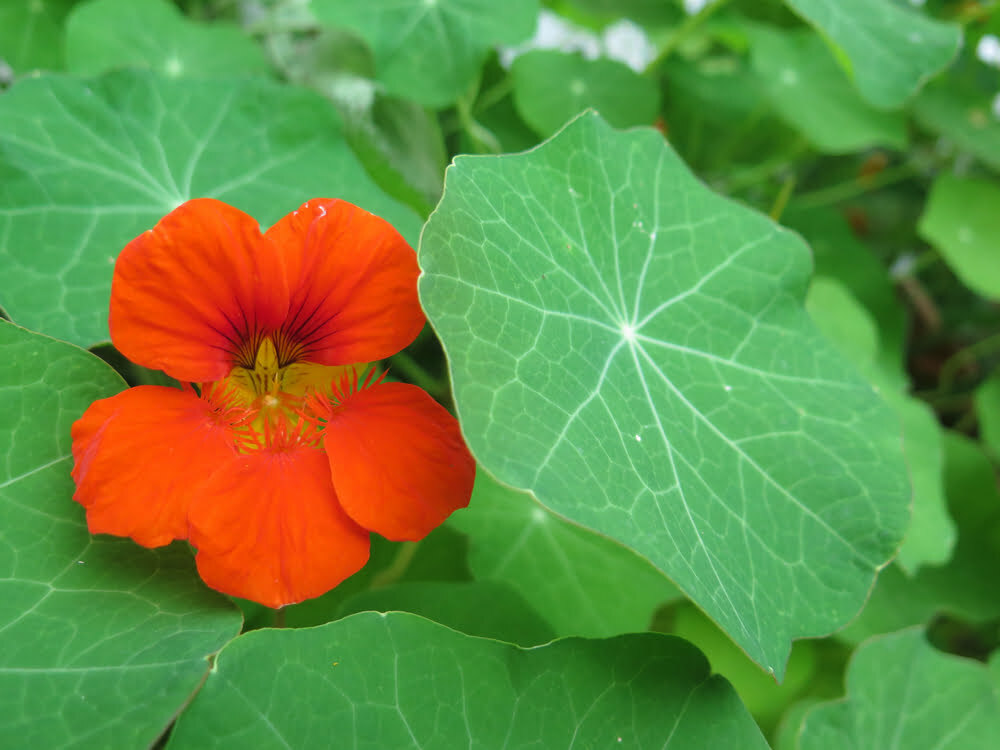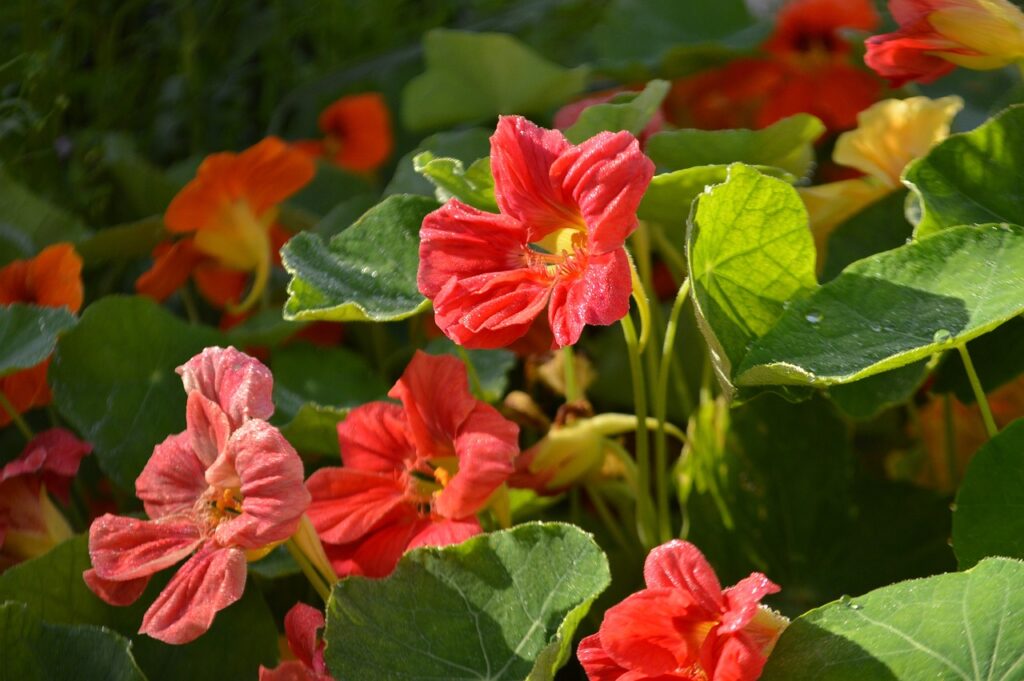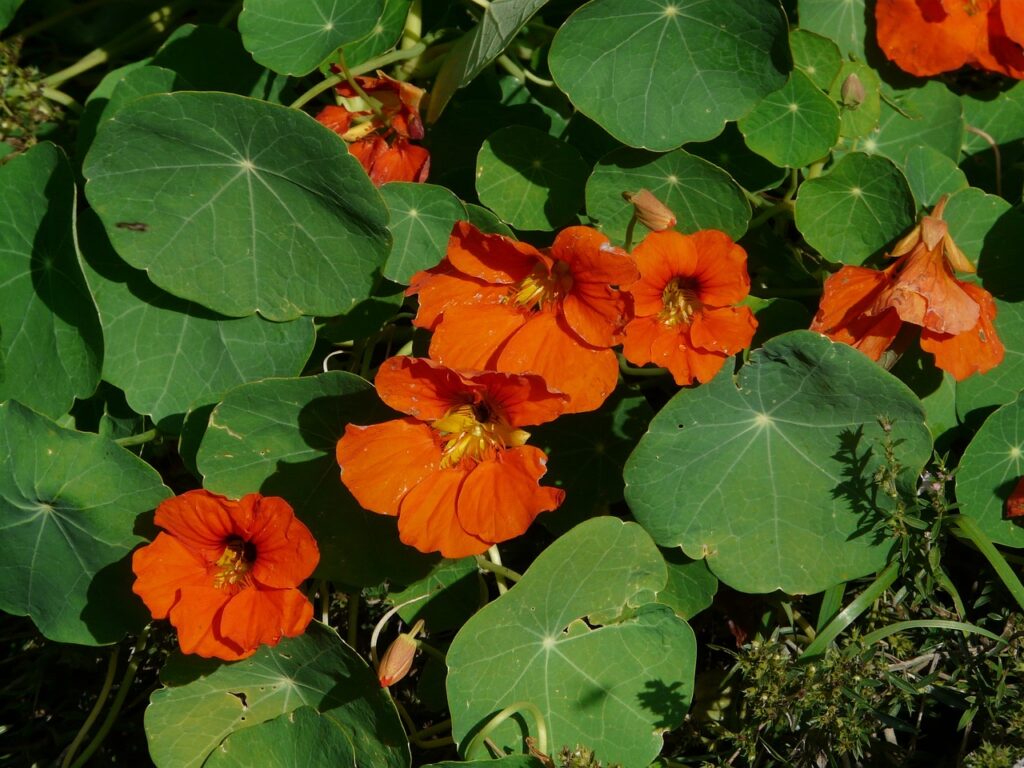In this Article
- 1 What are the benefits of growing nasturtiums?
- 2 Where is the best place to plant nasturtiums?
- 3 Where do nasturtiums go in a vegetable garden?
- 4 Tips for companion planting with nasturtiums
- 5 Growing nasturtiums to attract beneficial insects
- 6 Growing nasturtiums to repel pests
- 7 How to grow a nasturtium trap crop
- 8 Nasturtiums and the cabbage white butterfly
- 9 What are the best companions for nasturtiums?
Nasturtiums are a beautiful sight in any garden, producing a vibrant display of gorgeous flowers throughout the summer months. But did you know that these easy-to-grow plants bring a whole range of benefits to your garden? Companion planting with nasturtiums is an age-old gardening technique that can reduce pests and diseases and help attract beneficial insects. Let’s find out more!
What are the benefits of growing nasturtiums?
Nasturtiums are often underrated as a garden plant, added as an afterthought to fill small gaps or provide some extra colour. But these wonderful plants offer a whole host of benefits to the gardener, and we believe they deserve a spot in every garden. Here are the top ten reasons to grow nasturtiums:
- Nasturtiums are good companion plants for many different vegetable crops.
- The bright colours of nasturtium flowers attract beneficial pollinating insects.
- Strongly-scented nasturtium leaves repel many common garden pests.
- Nasturtium flowers, leaves, and seeds are all edible and rich in nutrients.
- Nasturtiums can be grown as a sacrificial trap crop for aphids.
- Secretions from the roots of nasturtiums are absorbed by neighbouring plants, helping to improve disease resistance.
- Nasturtiums can be used as a living mulch, providing ground cover that suppresses weeds and reduces water evaporation.
- Nasturtiums are easy to grow and can tolerate poor soil conditions.
- These edible plants have powerful antioxidant properties.
- And finally, nasturtium flowers are bright, cheerful, and very beautiful!
We do have to make a small disclaimer about many of the potential benefits of nasturtiums – unfortunately, scientific research into this topic is quite limited, so there is not always evidence available to verify these claims. However, like most companion planting techniques, the beneficial effects of the humble nasturtium have been observed by gardeners for many generations, so the potential of this plant should not be overlooked.

What is the best nasturtium for pest control?
There are many different types of nasturtiums, most of which are grown as ornamental plants for their beautiful flowers. However, if you have a specific job in mind for your nasturtium plants, such as pest control, what are the best varieties to grow?
There is no evidence that one variety of nasturtium is any more effective than the rest, so the best nasturtium for pest control is any nasturtium! When planting nasturtiums as a companion plant to attract beneficial insects, select a range of brightly coloured flowers to lure in bees, butterflies, and wasps that help pollinate your crops and keep pests under control.
Where is the best place to plant nasturtiums?
The joy of nasturtiums is that these easy-to-grow plants will thrive anywhere where they get plenty of sun and a little water. Nasturtiums grow well in poor soil, so they can be planted at the edge of your beds or even along the side of paths. The seeds can be pushed into soil-filled crevices in rock gardens or walls to create a beautiful floral display.
When companion planting nasturtiums, it is a good idea to place them in various locations around the garden. Studies have shown that a method called polyculture is the most effective way to confuse and deter garden pests. Polyculture planting is where many different types of plants share the same growing space, rather than growing individual crops in separate blocks. Polyculture gardens can be beautifully haphazard and eye-catching, but far less orderly than a traditional vegetable garden.

Where do nasturtiums go in a vegetable garden?
Because nasturtiums have such wide-ranging benefits as a companion plant, they can be grown in any area of the vegetable garden providing there is sufficient space. Remember that our nasturtiums are going to do three jobs for the price of one – attract beneficial insects, repel garden pests, and act as a trap crop for aphids. This will benefit most vegetable crops, but some have a particularly harmonious relationship with nasturtiums:
- Cucurbit crops – cucumber, squash, courgette, melon
- Radishes
- Beans
- Tomatoes
Tips for companion planting with nasturtiums
Because nasturtiums have a vigorous growth habit, it is a good idea to check your planned planting zone carefully to ensure these large, mound-like plants cannot swamp small or slow-growing vegetable crops. For example, onions and carrots may quickly disappear under the foliage of this fast-growing companion plant, leading to slow growth and low yields.
Can you plant nasturtiums next to tomatoes?
Nasturtiums are one of the best companion plants for tomatoes, and you will often see the two grown together. Here are five reasons why companion planting nasturtiums with tomatoes is a good idea:
- Nasturtiums attract beneficial insects such as ladybirds, hoverflies, and lacewings.
- The scent of nasturtiums repels whiteflies.
- Nasturtiums will lure aphids away from tomato plants.
- Pollinating insects are attracted to nasturtium flowers.
- Nasturtium flowers are edible and taste great in a tomato salad.
Growing nasturtiums to attract beneficial insects
In recent years, gardeners have become more aware of the important role that beneficial insects play in our gardens. These can be broadly grouped into two types – insects that pollinate plants, and insects that eat other bugs. Some beneficial insects carry out both roles.
Here are some of the beneficial garden insects you may see if you grow nasturtiums:
- Hoverflies
- Ladybirds
- Lacewings
- Parasitoid wasp
- Solitary bees
But why are these beneficial insects so important? Well, we’ve come to realise that nature is highly effective at maintaining balance in the ecosystem, and these creatures will do a far better job of tending to our plants than we could ever do. Insect populations have been decimated by widespread pesticide use, but by attracting them into our gardens by creating the ideal habit and food source we can start to restore the balance.

Growing nasturtiums to repel pests
The pungent smell of nasturtiums is a great way to deter creatures that enjoy eating your precious garden plants. This strong aroma is thought to confuse insects, masking the scent of their preferred target plant. Whiteflies, flea beetles, vine borers, and squash bugs are all deterred by the smell of nasturtiums.
How to grow a nasturtium trap crop
Growing nasturtiums from seeds is easy and as a trap crop means you deliberately place plants in key areas of the garden to attract insects that will devour it. This might sound counterproductive, but using sacrificial plants like nasturtiums in this way is a highly effective way to improve the ecosystem and natural pest control in your garden.
Nasturtiums are commonly grown as a sacrificial trap crop for aphids. These tiny insects are a nightmare for the vegetable gardener, causing widespread damage to tender young plants. Aphid infestations are difficult to deal with once they occur, but with some forward planning, it is possible to halt this plague of insects in their tracks.
The idea of planting nasturtiums as a sacrificial trap crop is not to just lure aphids away from your plants, but also to attract beneficial insects that will devour these troublesome bugs. It can take a few weeks for populations of the ‘good’ insects to become sufficient to restore balance in your garden, so by planting nasturtiums as early as possible we can get ahead of the game ready for planting out vegetable seedlings later in the season.
Aphid activity begins when warmer weather arrives in mid-spring. Luckily, nasturtiums are hardy plants that can be sown outdoors in the UK from March onwards, enabling you to get the seeds in the ground early enough to grow into full-size plants before the aphid population arrives. You will see that your nasturtium plants quickly become overrun with aphids, but this will be followed by the arrival of beneficial insects that love to feast on these destructive bugs. They might not be in time to save your nasturtium plants, but you’ll have a ready and willing army of insects waiting to protect your summer vegetable crops!
Nasturtiums and the cabbage white butterfly
The cabbage white butterfly is notorious for its ability to destroy brassica crops. These pretty white butterflies lay their eggs on the underside of the leaves of cabbages and kale, where they hatch into very hungry caterpillars that devour the foliage within a matter of days.
There are not many other plants that attract the cabbage white butterfly, but they can be lured away from your vegetable plants with nasturtiums. Of course, this means your nasturtium plants will get eaten by the caterpillars, but it could save your vegetable crop from total destruction.
It is important to note that nasturtiums should not be grown directly alongside brassica crops, as they are not compatible in the same growing space. However, by planting nasturtiums elsewhere in the vegetable garden, you can lure cabbage white butterflies away from your cabbages, kale, broccoli, and Brussels sprouts.
What are the best companions for nasturtiums?
So, we can dot nasturtium plants all around the vegetable plot, but are there any other plants that particularly benefit from growing near this versatile and highly useful plant? Nasturtiums are ideal for planting at the base of young fruit trees, where they act as a living mulch and help to suppress other weeds. Smaller bush varieties of nasturtiums can also work well in a herb garden, particularly alongside parsley and chives.

